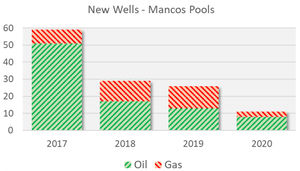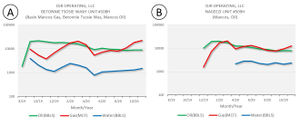Mancos Shale Play in New Mexico
By Bruce Hart, Western University, London, Ontario, Canada
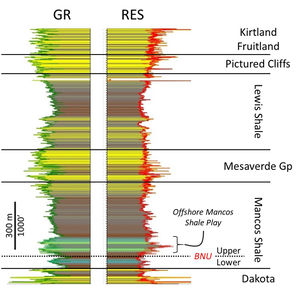
Sharp reductions in demand for oil and gas dramatically affected drilling in the San Juan Basin of New Mexico and Colorado. This summary focuses on the Mancos Shale play in the period 2017-2020 although other unconventional targets (e.g., tight-gas plays of the Dakota and Mesaverde, CBM from the Fruitland Coal) have been drilled and produced for more than 70 years. Figure 1 shows a type log through the Cretaceous section of the San Juan Basin.
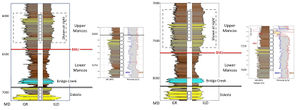
As noted by Broadhead[2] the San Juan Basin’s “Mancos Play” really consists of three separate plays.
- The “Tocito marine bar play” is a halo play, targeting low-quality reservoir adjacent to the conventional Tocito oil pools that were mostly developed in the 1950s-1970s.
- The “Naturally fractured Mancos Shale play” targets naturally fractured shaly sandstones and sandy shales adjacent to the tectonically deformed eastern margin of the basin. Natural fractures provided the system permeability that allowed vertical wells to produce at economic rates.
- The “Offshore Mancos Shale play” targets shales and shaly sandstones, including both low-quality reservoir rocks and Type II-III source rocks. As such, it is best described as a hybrid play.
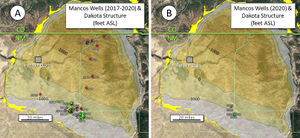
Figure 2 shows examples of the intervals historically completed as Mancos wells from the Offshore Mancos Shale play using vertical wells. The Mancos is divided into two members, Upper and Lower, separated by an unconformity (Base Niobrara Unconformity, BNU) that formed near the end of the Turonian. Mancos production is almost invariably from the Upper Mancos, from an interval sometimes called El Vado or Niobrara. Unfortunately, some pools that produce from the same stratigraphic level are also called Gallup, although that name is stratigraphically incorrect. Shoreline sandstones of the Gallup sit stratigraphically below the BNU.
For simplicity, this summary is restricted to wells assigned to Mancos pools by the New Mexico Oil and Gas Conservation Division. These pools include the Basin Mancos, Lybrook Mancos, Alamito North Mancos, Escavada North Mancos, and the Nageezi Unit. These are the main areas targeted by drilling in the past 5 years.
Oil and gas have been produced from the Upper Mancos interval for more than 50 years, although horizontal drilling has rejuvenated the play in recent years. In many or most vertical wells, production from these levels is comingled with production from stratigraphically lower units (e.g., the Dakota; Figure 2) or higher units (e.g., Mesaverde, Pictured Cliffs, Fruitland; Figure 1). In the past decade, horizontal drilling in this play has generally targeted shaly sandstones in the Upper Mancos.
Figure 3A shows the locations of wells drilled in any of those pools in the years 2017-2020. Oil wells are concentrated in the southern, structurally shallower part of the basin. Gas wells are also present in this area, and gas wells extend north into the deepest parts of the basin. Of the 125 wells shown on that map, only one was a vertical well, the rest were all horizontal wells. Figure 3B shows the locations of the 11 Mancos wells drilled in 2020. All were drilled horizontally, and all were drilled in the southern part of the basin. Eight of the 11 were drilled in the Alamito North Mancos (oil) pool, two gas wells were assigned to the Basin Mancos play, and the final well was plugged. As of January 2021, none of the wells had production reported to the New Mexico Oil and Gas Conservation Division.
Figure 4 shows the number of wells drilled into Mancos Pools for 2017-2020. Note the precipitous drop between 2017 (59 wells drilled in Mancos pools) and 2018 (29 wells), with a further drop in 2020. Most drilling is obviously targeting liquids. It should be noted that although wells are sometimes designated as oil or gas producers, all wells in this area produce a mixture of oil, gas, and water, as seen in Figure 5.
References
- ↑ 1.0 1.1 Hart, B. S., 2021, Stratigraphy and Hydrocarbon Resources of the San Juan Basin: Lessons for Other Basins, Lessons from Other Basins: The Mountain Geologist, v. 58, p. 43-103.
- ↑ Broadhead, R. F., 2018, The Upper Mancos Shale in the San Juan Basin: Three oil and gas plays, conventional and unconventional: Update, AAPG Search and Discovery Article 11096, Accessed June 23, 2019, http://www.searchanddiscovery.com/pdfz/documents/2018/11096broadhead/ndx_broadhead.pdf.html.
- ↑ Craigg, S. D., 2001, Geologic framework of the San Juan Structural Basin of New Mexico, Colorado, Arizona, and Utah, with emphasis on Triassic through Tertiary rocks: U.S. Geological Survey Professional Paper 1420, 70 p.
